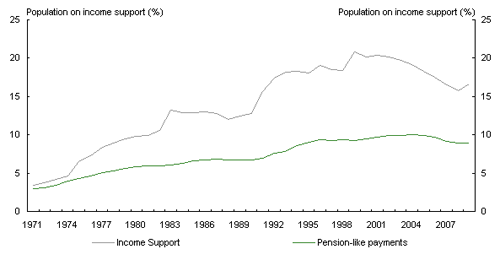Cutting off a nose or two won't stop the smell

Tony Abbott has called for a “tough love crackdown” on welfare recipients, including tightening of the entry requirements for the disability pension, unemployment benefits and work for the dole arrangements.
"To keep people on welfare when there is an alternative is the kindness that kills, it's the misguided compassion that ultimately destroys the social fabric, even of a strong society," Mr Abbott said.
The Gillard government is about to do the same.
Both the Liberals and the ALP have noted a significant increase in the number of people receiving disability support payments over the last three decades. As pointed out in the Henry tax review, there has been an increase in the population receiving disability payments. If fact the number of people on pensions of all types has grown from 3% to 9% of the population since 1971.
Percentage of working-age population receiving income support and pension payments (1971–2009)

Pension payments include: Age Pension; Disability Support Pension; Parenting Payment Single; and Carer Payment.
Source: Annual ABS population figures for people aged 15 to 64 and Australian government administrative data.
Both sides of Parliament are focussed on lowering the numbers receiving payments by reducing access. Tightening the system in these tougher times may be needed, however, focussing only on the costs and creating obstacles to reduce access to people as the remedy will only lead to suffering if change does not also include incentives and support.
Australia is not alone in this dilemma. Countries around the world have been forced to tackle this issue. There may be little fiscal choice for governments, however, there are clear options in the way new policies is developed and applied. There is potential social progress to be found here rather than the simple spreading of a blanket of suffering.
The meaningful way to reduce demand on pensions is to return people to work.
There are many complex reasons why people end up off work, and confronting the diversity of these issues and turning them around is challenging. An approach that supports people, identifies their particular issues, while tackling the problems at their heart is key to the success of any long term strategy.
How and why do people reach the Disability Support Pension (DSP)? What proportion move from unemployment benefits to the DSP? What percentage have a worker’s compensation claim and become ‘disabled’ through the tangled web of proving ill health to deal with that claim, only to then transition to the DSP when their claim is settled?
Developing a rich understanding of the paths and personal motives of people through answering these questions will enable the creation of policies able to deal with the complex array of needs. Holding as a primary focus the development of people skills and confidence within return to work policy is a path that will lead to improved workforce participation and an engaged community.
A cash strapped UK is tightening entry requirements to receive incapacity benefits. But they are also trying to identify ways to help people return to the workforce. Among the initiatives underway is a major review of the sickness absence system.
The UK is also piloting a number of support approaches. http://www.dwp.gov.uk/health-work-and-well-being/our-work/
One is the Fit For Work Service. These are regional centres founded on the fundamental principle that work is generally good for one’s health. The centres provide case managers who deal with the range of issues regarding work and health. For example an employer may have someone who is at work, but struggling to cope with a health problem. The Service provides support and assistance to keep that person in work. See: http://www.dwp.gov.uk/health-work-and-well-being/our-work/fit-for-work-services/
Case managers also deal with people who are out of work. They have the flexibility to move away from the medical model. This means they don't have to be stuck in the person's diagnosis, and formalise capacity (or the lack of it) around that diagnosis. Instead they are able to talk to people about other real issues, like concluding that they don't think they can return to that workplace because of the way it is run, or the negative relationships that have developed. The Fit For Work Service can provide clients with financial counselling, assistance with problem solving, or simply help a client recognise that they're too old to do a manual type job anymore.
A pilot program of providing advice to GPs is also under way. The GP can ring up an advice line, to identify services that may help an employee remain at work or return to work. Employers have access to a similar service.
The UK government has also set up the public service as an exemplar employer. For example, the National Health Service is developing improved systems to care for the health and well-being of its staff. Similarly, Local Government is working on health and well-being to demonstrate what can be achieved through improved care of employees.
The UK recognises the importance and the challenges of the task and has set up a cross government approach to deal with it.
In Australia, we need a similar approach, policy that causes the Department of Health and the Department of Employment and Workplace Relations to work together, create a partnership that can provide significant opportunities to improve the health and well-being of Australia's workforce and help long term out of work people back into the workplace. We need positive initiatives that are designed to help people, not just a knee jerk big stick policy that tightens benefits for short term gain while creating deeper long term social problems for the future.
Published 08 April, 2011

